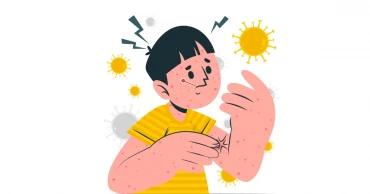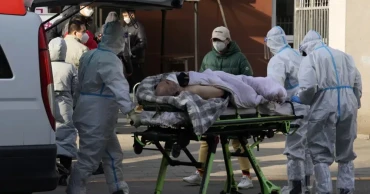Infection
Measles: Causes, Symptoms and Prevention
Measles, a highly contagious viral infection, has been a persistent health concern worldwide. Understanding the symptoms and causes of measles is crucial for individuals and communities to combat its spread effectively. In the wake of a recent measles outbreak in Europe, understanding the symptoms and causes of this highly contagious viral infection is more crucial than ever.
What is Measles? How Does It Affect People?
Measles is characterised by fever, cough, and a distinctive rash. The virus responsible for measles is a paramyxovirus (known as rubeola), and its high contagiousness often leads to outbreaks, especially in areas with low vaccination rates. This contagious viral disease easily spreads through respiratory droplets when an infected person breathes, coughs, or sneezes.
While capable of affecting anyone, it predominantly targets children. Measles initiates in the respiratory tract and then disseminates throughout the body. As a highly contagious disease, it underscores the importance of preventive measures, with vaccination being the most effective way to shield against severe illness, complications, and potential fatalities.
Read more: Foods that Help Relieve Nausea and Vomiting
What are the Symptoms of Measles?
The symptoms of measles typically manifest 10–14 days after exposure to the virus, with a prominent rash being the most evident sign. Early symptoms persist for 4–7 days and include
- A high fever- Runny nose - Cough - Red and watery eyes - Tiredness- White spots inside the cheeks, known as Koplik's spots
The characteristic rash emerges approximately 7–18 days post-exposure, starting on the face and upper neck, and gradually spreading to the hands and feet over about 3 days. This rash persists for 5–6 days before fading. Other measles symptoms may include
- A sore throat- White spots in your mouth- Muscle pain- Sensitivity to light.
Read more: Which Vitamins are Essential for Women?
What are the Causes of Measles?
The measles virus, belonging to the Paramyxoviridae family, is renowned for its highly contagious nature. Spread primarily through respiratory droplets, it easily transmits from person to person. Measles is exceptionally contagious, with individuals at risk of contracting the virus even after an infected person has left the vicinity.
The virus can endure on surfaces and in the air for hours, posing a continual threat. Originating in the nose and throat, measles is transmitted when an infected person coughs, sneezes, or talks, releasing infectious droplets into the air. These droplets, both airborne and on surfaces, remain contagious for several hours, facilitating the virus's easy transmission.
Measles Health Risks
The primary cause of death resulting from measles is often complications associated with the disease. These complications encompass various serious issues
- Blindness- Encephalitis, an infection leading to brain swelling and potential brain damage- Severe diarrhea, accompanied by dehydration- Ear infections- Severe respiratory problems, including pneumonia.- In the case of a pregnant woman contracting measles, it poses a significant risk, endangering both the mother and potentially resulting in premature birth with a low birth weight for the baby.
Read more: How to Protect Babies and Children from Dengue Fever
Complications, often leading to fatalities, are more prevalent in children under 5 and adults over 30, especially those malnourished or with weakened immune systems, as measles itself can compromise the body's ability to defend against infections, rendering children exceptionally vulnerable.
1 year ago
10 Tasty Drinks to Boost Kids' Immunity This Winter
As winter rolls in, it brings cold waves and fog. In chilly weather, kids may catch cold and fall ill more frequently. However, there are some secret weapons to combat these seasonal maladies: immunity-boosting winter drinks! Discovering tasty and healthy options to fortify children's immunity can make winter an enjoyable journey. Let's explore palatable winter drinks that not only tantalise the taste buds of children but also serve as shields against sickness during the cold months.
10 Delicious Immunity-Booster Winter Drinks for Children
Turmeric Milk
Turmeric milk is known for its medicinal properties. This drink blends the beneficial properties of turmeric and warm milk. To prepare, heat a cup of milk first. Then add half a teaspoon of turmeric powder, a pinch of black pepper, and a dash of honey to the milk. Simmer the mixture for a few minutes, then strain before consumption.
This golden elixir boasts curcumin which is renowned for its anti-inflammatory and antioxidant properties. Consuming turmeric milk helps bolster the immune system, aiding in the prevention of winter ailments like colds and flu. Its natural healing properties provide relief from sore throats, coughs, and other seasonal maladies.
Read more: 10 Types of Natural Honey: A Guide to Varieties, Benefits, and Uses
Vegetable Soup
Vegetable soup, a wholesome blend, incorporates an array of vegetables like carrots, spinach, tomatoes, and onions. Simmer these veggies in a broth, then season with some herbs and spices. This nutritious soup is filled with a plethora of nutrients, vitamins, minerals, and antioxidants, fortifying kids' natural immune systems and aiding in preventing colds and flu.
The warmth, nourishment, and hydration provided by this soup make it an appealing and immunity-boosting choice to keep kids healthy while relishing an appetizing meal.
Orange Carrot Juice
A vibrant and refreshing drink, orange carrot juice is a burst of immunity-boosting nutrients. Combine equal parts of carrot and orange juices for a rich blend of vitamin C and beta-carotene. These ingredients can fortify the immune system, essential in shielding kids from winter ailments.
Read more: Superfoods: Worth the Hype?
The juice's high vitamin content bolsters immunity, warding off cold and flu during colder months. The antioxidants in this juice act as a defence mechanism, aiding in preventing illnesses, while its delicious taste makes it kid-friendly.
Pumpkin Seed Milk
Pumpkin seed milk is another delightful way to keep winter ailments at bay for the little ones. This remedy involves blending soaked pumpkin seeds with water and straining the mixture. Rich in zinc, antioxidants, and omega-3s, it safeguards kids against winter sickness.
This nutritious vegan delight acts as a shield against seasonal ailments by fortifying the body's defence mechanisms. Its high zinc content aids in immune response, while antioxidants combat free radicals. Providing a wealth of nutrients, including magnesium and vitamin E, pumpkin seed milk contributes to overall health, offering an extra layer of winter protection.
Read more: Prospects of Safe Broiler Chicken Farming
Fruit Smoothies
Organic fruits are loaded with vitamins, antioxidants, and essential nutrients. Preparing smoothies involves blending a variety of fruits such as berries, bananas, and oranges, with a splash of yoghurt or milk. Each sip is a celebration of the body's strength.
The fruit medley provides a powerhouse of vitamins C and E, crucial for fortifying their defences and warding off colds. Its richness in antioxidants aids in fighting off infections, ensuring a tasty and convenient way for kids to stay healthier during colder months.
1 year ago
China struggles with COVID infections after controls ease
A rash of COVID-19 cases in schools and businesses were reported by social media users Friday in areas across China after the ruling Communist Party loosened anti-virus rules as it tries to reverse a deepening economic slump.
Official data showed a fall in new cases, but those no longer cover big parts of the population after the government on Wednesday ended mandatory testing for many people. That was part of dramatic changes aimed at gradually emerging from “zero-COVID” restrictions that have confined millions of people to their homes and sparked protests and demands for President Xi Jinping to resign.
Social media users in Beijing and other cities said coworkers or classmates were ill and some businesses closed due to lack of staff. It wasn’t clear from those accounts, many of which couldn’t be independently confirmed, how far above the official figure the total case numbers might be.
“I’m really speechless. Half of the company’s people are out sick, but they still won’t let us all stay home,” said a post signed Tunnel Mouth on the popular Sina Weibo platform. The user gave no name and didn’t respond to questions sent through the account, which said the user was in Beijing.
The reports echo the experience of the United States, Europe and other economies that have struggled with outbreaks while trying to restore business activity. But they are a jarring change for China, where “zero COVID,” which aims to isolate every case, disrupted daily life and depressed economic activity but kept infection rates low.
Xi’s government began to loosen controls Nov. 11 after promising to reduce their cost and disruption. Imports tumbled 10.9% from a year ago in November in a sign of weak demand. Auto sales fell 26.5% in October.
“Relaxing Covid controls will lead to greater outbreaks,” said Neil Thomas and Laura Gloudeman of Eurasia Group in a report, “but Beijing is unlikely to return to the extended blanket lockdowns that crashed the economy earlier this year.”
Read: China eases controls, gives no sign when ‘zero COVID’ ends
The changes suggest the ruling party is easing off its goal of preventing virus transmission, the basis of “zero COVID,” but officials say that strategy still is in effect.
Restrictions probably must stay in place at least through mid-2023, public health experts and economists say. They say millions of elderly people need to be vaccinated, which will take months, and hospitals strengthened to cope with a surge in cases. Officials announced a vaccination campaign last week.
On Friday, the government reported 16,797 new cases, including 13,160 without symptoms. That was down about one-fifth from the previous day and less than half of last week’s daily peak above 40,000.
More changes announced Wednesday allow people with mild COVID-19 cases to isolate at home instead of going to a quarantine center that some complained were crowded and unsanitary. That addressed a major irritant for the public.
A requirement for subway riders, supermarket shoppers and others to show negative virus tests also was dropped, though they still are needed for schools and hospitals.
A post signed Where Dreams Begin Under Starlight by a user in Dazhou, a southwestern city in Sichuan province, said all but five students in a public school class of 46 were infected.
“It’s really amazing that the school insists students go to school,” the user wrote. The user didn’t respond to a question sent through the account.
The requirement for hundreds of millions of people to be tested as often as once a day in some areas over the past two years helped the government spot infections with no symptoms. Ending that approach reduces the cost of monitoring employees and customers at offices, shops and other businesses. But it increases the risk they might spread the virus.
This week’s changes follow protests that erupted Nov. 25 in Shanghai, Beijing and other cities against the human cost of “zero COVID.”
It isn’t clear whether any of the changes were a response to protests, which died out following a security crackdown.
The ruling party’s Politburo on Wednesday declared stabilizing weak economic growth its priority, though leaders have said local officials still are expected to protect the public.
“The re-pivot to growth and the exit from zero-Covid are clear from the top level,” said Larry Hu and Yuxiao Zhang of Macquarie Group, an Australian bank, in a report. However, they warned, “uncertainties remain high,” including “how disruptive the exit of zero-Covid could be.”
Party leaders stopped talking about the official 5.5% annual growth target after the economy shrank by 2.6% from the previous quarter in the three months ending in June. That was after Shanghai and other industrial centers shut down for up to two months to fight outbreaks.
Private sector economists have cut forecasts of annual growth to as low as below 3%, which would be less than half of last year’s 8.1% and among the weakest in decades.
Social media posts suggested some cities might have outbreaks that weren’t reflected in official figures.
Read: China reports 2 new COVID deaths as some restrictions eased
Posts dated Thursday by 18 people who said they were in Baoding, a city of 11 million southwest of Beijing, reported they tested positive using home kits or had fevers, sore throats and headaches. Meanwhile, the Baoding city government reported no new cases since Tuesday.
Drugstores were mobbed by customers who bought medications to treat sore throats and headaches after rules were dropped that required pharmacists to report those purchases, prompting fears a customer might be forced into a quarantine center.
Also Friday, the market regulator announced prices of some medicines including Lianhua Qingwen, a traditional flu treatment, rose as much as 500% over the past month. It said sellers might be punished for price-gouging.
Lines formed outside hospitals, though it wasn’t clear how many people wanted treatment for COVID-19 symptoms.
People waited four to five hours to get into the fever clinic of Chaoyang Hospital in Beijing, according to a woman who answered the phone there and would give only her surname, Sun. She said no virus test was required but patients had to show a smartphone “health code” app that tracks their vaccine status and whether they have been to areas deemed at high risk of infection.
Hong Kong, which enforces its own anti-virus strategy, has faced a similar rise in cases as the southern Chinese city tries to revive its struggling economy by loosening controls on travel and the opening hours of restaurants and pubs.
Hong Kong reported 75,000 new cases over the past week, up about 25% from the previous week. But those don’t include an unknown number of people who stay at home with COVID-19 symptoms and never report to the government.
3 years ago
Bangladesh sees one more Covid death, 170 cases
One more person died from Covid, and 170 tested positive for the virus in Bangladesh in the 24 hours to Thursday morning.
While the country's total fatalities reached 29,315, the new number took its caseload to 2,009,604, according to the Directorate General of Health Services (DGHS).
The daily case test positivity rate fell to 3.52 percent from Wednesday's 4.54 percent as 4,824 samples were tested.
The mortality rate remained unchanged at 1.46 per cent. The recovery rate rose to 97.18 percent from Wednesday's 97.17 percent.
In July, the country reported 142 Covid-linked deaths and 31,422 cases, the highest monthly death toll and caseload since March this year.
Bangladesh registered its highest daily caseload of 16,230 on July 28 last year and daily fatalities of 264 on August 10 in the same year.
Read: Covid-19: Bangladesh logs one death, 1,104 new cases
3 years ago
Dengue numbers keep rising: 92 new cases reported
Ninety-two more people were hospitalised with dengue – a viral infection – in the 24 hours to Saturday morning as cases have continued to increase in Bangladesh.
Eighty-nine new patients were admitted to the hospitals of Dhaka and three outside it, according to the Directorate General of Health Services (DGHS).
Three hundred and fifty-five dengue patients, including 284 in the capital, are now receiving treatment at hospitals across the country.
This year's death toll from the mosquito-borne viral disease rose to 16 Thursday with one more death reported from Dhaka.
Read: Dengue: 24 new patients hospitalised
On June 21, the DGHS reported the first death of the season from the viral disease. In July, it recorded 1,571 dengue cases and nine deaths.
This year, the DGHS has recorded 3,643 dengue cases and 3,272 recoveries so far.
3 years ago
Bangladesh reports first zero Covid death after June 29
Bangladesh reported zero Covid death and 216 cases in the 24 hours to Sunday morning.
The country last reported zero Covid-linked death on June 29.
While Bangladesh's total fatalities remained unchanged at 29,302, the new number took its caseload to 2,007,335, according to the Directorate General of Health Services (DGHS).
The daily case test positivity rate dropped to 5.10 percent from Saturday's 5.56 percent as 4,233 samples were tested.
The mortality rate remained unchanged at 1.46 percent. The recovery rate rose to 97.05 from Saturday's 97.02 percent.
Read: Covid-19 in Bangladesh: Around 21 pc of total deaths reported in April alone
In July, Bangladesh reported 142 Covid-linked deaths and 31,422 cases – its highest death toll and caseload since March this year.
The country first reported its zero Covid death on November 20 last year since the pandemic broke out here in March 2020.
Bangladesh registered its highest daily caseload of 16,230 on July 28 last year and daily fatalities of 264 on August 10 the same year.
3 years ago
Dengue: 31 patients hospitalised in 24hrs
Thirty-one more dengue patients were hospitalised in 24 hours till Friday morning amid a rise in the mosquito-borne disease in Bangladesh, according to the Directorate General of Health Services (DGHS).
Among them, 30 patients were hospitalised in Dhaka, it said.
As many as 186 dengue patients, including 145 in the capital, are now receiving treatment at hospitals across the country.
The dengue cases are rising in the capital allegedly due to insufficient measures taken by the two Dhaka city corporations for preventing mosquito-borne diseases like dengue.
Read: 48 more dengue cases reported in Bangladesh
On June 21, the DGHS reported the first death of the season from the mosquito-borne viral disease.
This year, the DGHS has recorded 1,610 dengue cases and 1,423 recoveries so far.
Although dengue – a leading cause of serious illness and death in some Asian and Latin American countries – was first reported in Bangladesh in 1964, the first epidemic occurred in 2000, claiming 93 lives that year. It has since become endemic in the country, with outbreaks recorded every year since. Although for a three-year period at one point, the number of deaths from the virus fell almost near zero, its most fatal year yet was in 2019, when 179 died experiencing the severe form of the disease.
When the Covid-19 pandemic hit in 2020, it seemed to take a backseat, as only three deaths were reported from dengue that year.
However, 105 dengue patients, including 95 in Dhaka division, died in 2021.
Dengue is found in tropical and sub-tropical climates worldwide, mostly in urban and semi-urban areas.
About 4 billion people, almost half of the world's population, live in areas with a risk of dengue, according to the US Centers for Disease Control and Prevention.
Each year, up to 400 million people get infected with dengue while approximately 100 million get sick from infection, and 40,000 die from severe dengue, it says.
"There is no specific treatment for dengue or severe dengue. Early detection of disease progression associated with severe dengue, and access to proper medical care lowers fatality rates of severe dengue to below 1 per cent," according to the World Health Organization.
3 years ago
Bangladesh logs 6 more Covid deaths with 1,324 cases
Bangladesh logged six more Covid-linked deaths with 1,324 cases in 24 hours till Thursday morning amid a surge in cases again in the country.
The new numbers took the country's total fatalities to 29,223 while its caseload to 1,993,382, according to the Directorate General of Health Services (DGHS).
The daily case positivity rate however declined to 11.82 per cent from Wednesday’s 13.79 per cent as 11,126 samples were tested during the period.
Four of the deceased were men while two were woman.
Three of them were from Dhaka while another three were from Mymensingh division.
The mortality rate remained unchanged at 1.47 per cent. The recovery rate rose to 96.28 per cent as 1,747 patients recovered during the period.
Read: Bangladesh must stay alert against Covid-19 infections: Minister
In June, the country reported 18 Covid-linked deaths and 20,201 new cases, according to the DGHS.
Bangladesh reported its first zero Covid death on November 20 last year since the pandemic broke out here in March 2020.
The country registered its highest daily caseload of 16,230 on July 28 last year and daily fatalities of 264 on August 10 in the same year.
3 years ago
Bangladesh reports 4 Covid deaths with 1,728 cases Positivity rate now 16.89%
Bangladesh registered four more Covid-linked deaths with 1,728 cases in 24 hours till Wednesday morning amid rapid surge in new infections.
The fresh numbers took the country's total caseload to 1,984,700 and the total fatalities to 29,185, according to the Directorate General of Health Services (DGHS).
Read: Covid-19 cases in Bangladesh surge to 425,353; 19 more die in 24 hrs
The daily case positivity rate rose to 16.89 per cent from Tuesday’s 16. 74 per cent as 10,175 samples were tested during the period, said the DGHS.
Among the deceased, two each were men and women. Of them, three were from Dhaka and another from Chattogram division.
On Tuesday, the country recorded seven Covid-linked deaths with 1,998 cases.
The mortality rate remained unchanged at 1.47 per cent. The recovery rate declined to 96.23 per cent from Tuesday’s 96.28 per cent as 526 patients recovered during this period.
In June, the country reported 18 Covid-linked deaths and 20,201 new cases, according to the DGHS.
The country reported its first zero Covid death in a single day on November 20 last year, along with 178 cases, since the pandemic broke out here in March 2020.
The country registered its highest daily caseload of 16,230 on July 28 last year and daily fatalities of 264 on August 10 in the same year.
3 years ago
Bangladesh reports 2,241 new cases amid resurgence of Covid
Bangladesh registered 2,241 new Covid cases with zero death in 24 hours till Wednesday morning amid an upward trend of Covid infections.
The fresh cases took the country's total caseload to 1,971,602 and the total fatalities remained unchanged at 29,145, according to the Directorate General of Health Services (DGHS).
The daily-case positivity rate slightly dropped to 15.23 per cent from Tuesday’s 15.47 per cent as 14,912 samples were tested during the period, said the DGHS.
On Tuesday, the country recorded 2,087 cases with three deaths from Covid-19.
Read: Bangladesh must stay alert against Covid-19 infections: Minister
The mortality rate remained unchanged at 1.48 per cent. The recovery rate declined to 96.73 per cent from Tuesday’s 96.84 per cent as 152 patients recovered during this period.
In May, the country reported only four Covid-linked deaths and 816 new cases, while 7,356 patients recovered from the disease, according to the DGHS.
Among the four deaths during the period, one was vaccinated with a single dose of Covid vaccine while three were vaccinated with two doses.
The country reported its first zero Covid death in a single day on November 20 last year, along with 178 cases, since the pandemic broke out here in March 2020.
On January 28, Bangladesh logged its previous highest positivity rate of 33.37 per cent.
The country registered its highest daily caseload of 16,230 on July 28 last year and daily fatalities of 264 on August 10 in the same year.
3 years ago




.jpg)












